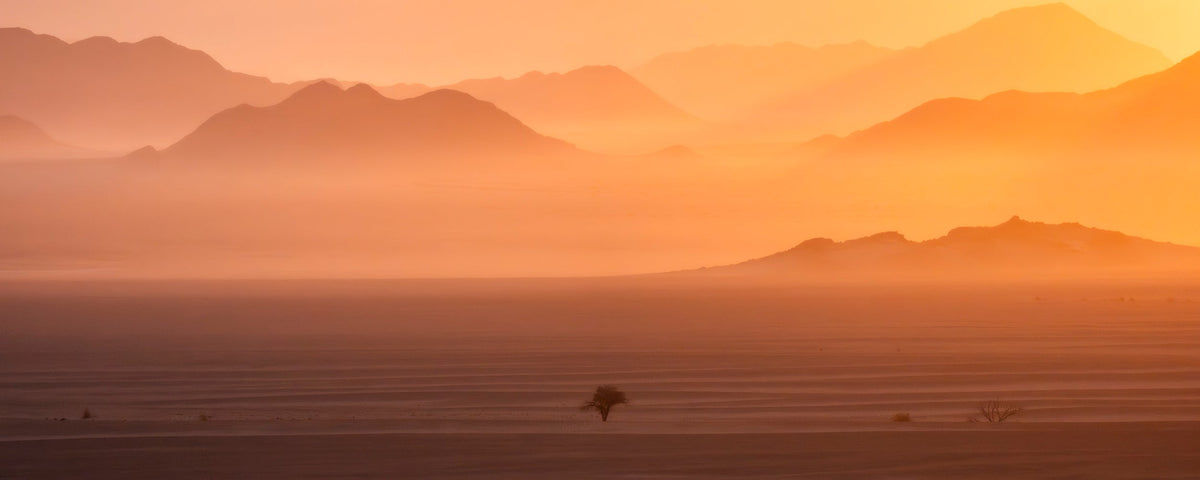

I wasn’t planning on ending up here. In fact, the desert wasn’t even on the map I’d been following. I tend to try and avoid the heat. One moment you’re chasing the ghosts of shadows through a canyon, the next you’re standing knee-deep in dunes that have been shifting since before men thought to name things.
The light comes sneaking over the ridge in the morning, gentle as a cat on silk, then spends the day robbing shadows until evening, when it turns to molten gold and pours itself across the sand as though the sun’s had one too many. You’ll find trees here that died centuries ago but still stand, black skeletons baked so dry they’ve given up trying to fall. And the animals are tough. An oryx will appear and vanish like it’s been watching you longer than you’ve been watching it.
The desert doesn’t tell you its secrets. It makes you earn them, frame by frame, heartbeat by heartbeat. And if you’re lucky, you’ll leave with something more than a photograph, as I learned in the Sahara. You’ll leave with a piece of the silence.
Days in the Namib stretch long and unhurried, bracketed by two windows of absolute magic, dawn and dusk.

Sossusvlei and Deadvlei: Where Time Stands Still
Our journey began in the iconic heart of the Namib Desert: Sossusvlei. Here, dunes rise like sleeping giants, their sinuous curves catching the light in gradients of gold and crimson. At sunrise, shadows stretch impossibly long, creating shapes that seem carved by the hand of an artist. This is a landscape that feels almost abstract, where every shift in light reveals a new composition.
We walked into Deadvlei, a clay pan frozen in time, where skeletal camelthorn trees, long dead yet perfectly preserved, stand against the brilliance of the sand. The cracked earth beneath our boots told a story of ancient floods and centuries of drought. As a photographer, it’s a dream, every angle offers a minimalist yet powerful scene, perfect for large-format Namibia fine art prints.
People often ask me why African landscapes work so well as statement pieces in modern interiors. It’s because they balance drama with restraint: bold colors and shapes paired with a meditative stillness. A photograph of Deadvlei becomes not just wall art but a daily invitation to slow down, breathe, and appreciate detail.


Wilderness Luxury in the Sands
Between shoots, we returned to the refined comfort of Wilderness Little Kulala, a desert lodge where design mirrors the landscape. Soft, neutral interiors open to vast views, and nights are spent dining under a sky so clear it feels infinite. Even in the most remote corners of Namibia, luxury is possible without disturbing the essence of place, a philosophy that mirrors my own approach to photography.
Every morning began before first light. The desert at dawn is silent except for the crunch of footsteps and the distant call of a bird. I would set up my tripod, waiting for the first line of sunlight to crest a dune. By mid-morning, the heat shimmer made photography impossible, but evenings brought a second golden hour, often more dramatic than the first.
South to the Desert Rhinos
From Sossusvlei, we traveled south to Desert Rhino Camp, a place that feels even more isolated. The journey itself was a reminder of Namibia’s scale — endless plains, distant mountains, and the occasional springbok flashing white as it bounded away.
Tracking desert-adapted black rhinos on foot is an experience that strips away everything except presence. The air was dry and warm, and the ground beneath us a mosaic of stone and sand. When we finally saw a rhino, it moved slowly, head down, scanning for sparse vegetation. Photographing it from a respectful distance, I thought about resilience — how life here has adapted over millennia to conditions that seem impossible.
This is more than wildlife photography. A print of a desert rhino against a backdrop of endless horizon becomes both a piece of décor and a statement on wildlife conservation, scarcity, and endurance.


The Sensory Desert
Namibia is a place you feel as much as you see. The wind here is not a gentle breeze but a sculptor, shifting sand into ridges and valleys that can disappear overnight. The light is unlike anywhere else, clear, unfiltered and unforgiving. At night, the stars arrive in layers, with the Milky Way so vivid it feels like a painted backdrop.
These sensory impressions influence how I edit and print my work. The tones of a Namib Desert print must carry the same depth as standing there, the rich warmth of evening light, the cool blue shadows at dawn, the pure white glare of midday. This attention to detail is what makes desert photography transcend a simple image and become a collector’s piece.


Looking Ahead: Etosha and the Skeleton Coast
While this trip focused on the Namib’s southern reaches, I’m already planning to return for Etosha National Park and the Skeleton Coast. Etosha offers vast salt pans and prolific wildlife, while the Skeleton Coast’s fog-shrouded dunes meet the Atlantic in stark contrast. Each will bring new opportunities to create desert and coastal fine art prints that expand this body of work.
Why Desert Photography Speaks to Collectors
Desert landscapes are about more than emptiness, they’re about form, color and mood distilled to their essence. In interior design, they work across styles - modern minimalism, rustic luxury, even coastal homes looking for contrast. A Namibia desert print can stand alone as a dramatic focal point or join a curated gallery wall to bring a sense of space and openness.
My goal is to create pieces that don’t just decorate a room but transform it, art that becomes part of the atmosphere, that changes with the light and continues to reveal details over time.

The Pull of the Desert
Desert photography resonates because it is elemental. It speaks to endurance, to resilience, to beauty stripped to its essentials.
In luxury interiors, a large-format desert print offers both impact and subtlety as a statement piece that’s as timeless as the landscape itself. Whether it’s the ochre curve of a Sossusvlei dune or the stark monochrome of Dead Vlei’s skeletal trees, these works invite a lingering gaze.
Explore the Namibia Collection
Bringing Namibia Home
For those who have traveled to Namibia, a fine art print is a way to keep the experience alive. For those who have not yet been, it’s an invitation, a promise of a place where time moves differently and beauty demands patience.
Every image from this trip is available as a limited-edition Namibia fine art print, meticulously printed and framed for longevity. These are not mass-produced posters but collectible artworks, each signed and numbered. Whether you’re drawn to the stark silhouettes of Deadvlei’s trees, the sweeping curves of Sossusvlei’s dunes, or the rare sight of a desert rhino, each piece is a fragment of a story, one you can carry into your own space.




